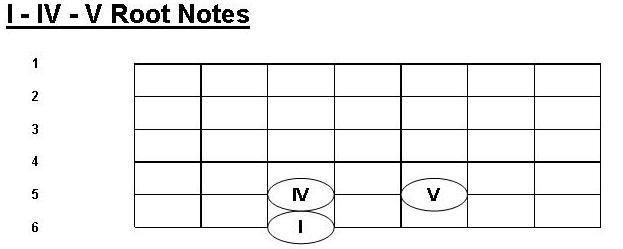As we learned last week in Confession #14 - Know What Chords to Play!, the I, IV and V chords in any major key are all major chords. Major chords have a happy feel to them and thus are very popular chords in all kinds of music. This makes the major chords very important chords to know.
In this week's confession, we'll learn how to quickly find the I, IV and V chord in any key by using Root 6 and Root 5 barre chords (see Confession #11 - Learn Root 6 Barre Chords! and Confession #12 - Learn Root 5 Barre Chords!).
STARTING ON A ROOT 6 BARRE CHORD
Let's say that you are playing a root 6 barre chord at the 5th fret of your sixth string, like this:
You would be playing a A chord (because the note at the 5th fret of the sixth string is an A).
If you treat the A chord as the I chord (i.e. the song is in the Key of A), then your IV chord will be the root 5 barre chord at the 5th fret of your fifth string, like this:
You would be playing a D chord (because the note at the 5th fret of the fifth string is an D).
And finally, the V chord will be the root 5 barre chord at the 7th fret of your fifth string, like this:
You would be playing an E chord (because the note at the 7th fret of the fifth string is an E)
Thus, in the Key of A, the I, IV and V chords are A, D and E.
You can use this pattern anywhere on the neck:
- Play a Root 6 barre chord as your I chord.
- Play a Root 5 barre chord at the same fret, and that's your IV chord.
- Play a Root 5 barre chord two frets higher, and that's your V chord.
If we focus just on the root notes of the chords, then you can think of it like this:
Note that I haven't given any fret numbers. That's because this works anywhere on the neck. Pick any note on the sixth string as the root of your I chord. The roots of the IV and V chord will be on the fifth string where shown above.
STARTING ON A ROOT 5 BARRE CHORD
Let's say that you are playing a root 5 barre chord at the 5th fret of your fifth string, like this:
You would be playing a D chord (because the note at the 5th fret of the fifth string is an D).
If you treat the D chord as the I chord (i.e. the song is in the Key of D), then your IV chord will be the root 6 barre chord at the 3rd fret of your sixth string, like this:
You would be playing a G chord (because the note at the 3rd fret of the sixth string is an G).
And finally, the V chord will be the root 6 barre chord at the 5th fret of your sixth string, like this:
You would be playing an A chord (because the note at the 5th fret of the sixth string is an A).
Thus, in the Key of D, the I, IV and V chords are D, G and A.
You can use this pattern anywhere on the neck:
- Play a Root 5 barre chord as your I chord.
- Play a Root 6 barre chord two frets lower, and that's your IV chord.
- Play a Root 6 barre chord two frets higher, and that's your V chord.
If we focus just on the root notes of the chords, then you can think of it like this:
Note that I haven't given any fret numbers. That's because this works anywhere on the neck. Pick any note on the fifth string as the root of your I chord. The roots of the IV and V chord will be on the sixth string where shown above.
Next Week's Confession - Finger 3-4 Independence! (Exercise #1)








No comments:
Post a Comment